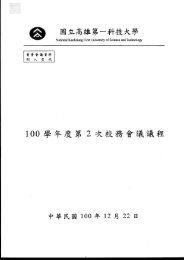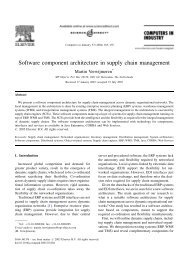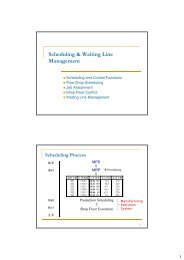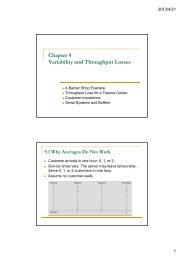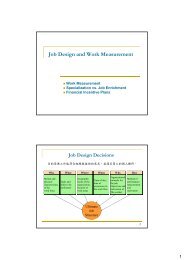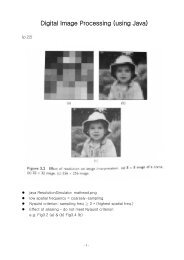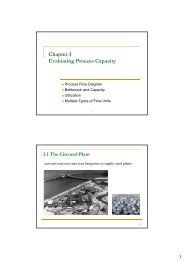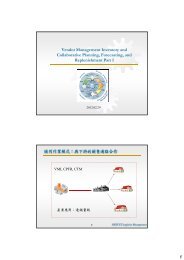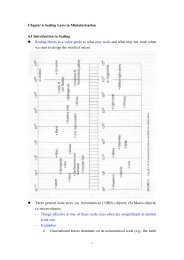Chapter 7 Variability and Waiting Time Problems Part II
Chapter 7 Variability and Waiting Time Problems Part II
Chapter 7 Variability and Waiting Time Problems Part II
Create successful ePaper yourself
Turn your PDF publications into a flip-book with our unique Google optimized e-Paper software.
<strong>Chapter</strong> 7 <strong>Variability</strong> <strong>and</strong> <strong>Waiting</strong><strong>Time</strong> <strong>Problems</strong> <strong>Part</strong> <strong>II</strong>• A Call Center Example• Arrival Process <strong>and</strong> Service <strong>Variability</strong>• Predicting <strong>Waiting</strong> <strong>Time</strong>s• Cost of <strong>Waiting</strong> <strong>Time</strong>s• <strong>Waiting</strong> Line Management1Predicting Average <strong>Waiting</strong> <strong>Time</strong>: One ServerInventorywaiting I qInventoryin service I pInflowOutflowEntry tosystem<strong>Waiting</strong> <strong>Time</strong> T qBeginServiceService <strong>Time</strong> pDepartureFlow <strong>Time</strong> T=T q+p2
The <strong>Waiting</strong> <strong>Time</strong> Formulaflow rate 1/ a putilizatio n = = = < 100%capacity 1/ p a2 2⎛ utilization ⎞ ⎛ CV + ⎞in queue = Activity <strong>Time</strong> × ⎜⎟× ⎜ aCV<strong>Time</strong>p⎟⎝1−utilization ⎠⎝ 2 ⎠Average flowtime TIncreasing<strong>Variability</strong>Service time factorUtilization factor<strong>Variability</strong> factorUtilization 100%3Multiple, Parallel Resources with One QueueInventoryin service I pInflowInventorywaiting I qOutflowFlow rateEntry to system Begin Service Departure<strong>Time</strong> in queue T q Service <strong>Time</strong> pFlow <strong>Time</strong> T=T q+p4
<strong>Waiting</strong> <strong>Time</strong> for Multiple, Parallel ResourcesUnder the assumption thatFlow rate 1/interarrival time 1/ a pUtilizatio n = == = < 1Capacity m × (1/ activity time) m/p a × mwe approximate the average waiting time as2( m+⎛ Activity time⎞⎛= ⎜⎟× ⎜utilization<strong>Time</strong> in queue⎝ m ⎠⎝ 1−utilization1) −12⎞ ⎛ CVa+ CV⎟×⎜⎠ ⎝ 22p⎞⎟⎠5Service Levels in <strong>Waiting</strong> Systems1Fraction ofcustomers who 0.8have to wait xseconds or less0.60.4<strong>Waiting</strong> times for those customerswho do not get served immediatelyFraction of customers who getserved without waiting at all0.2<strong>Waiting</strong> time [seconds]00 TWT 50 100 150 200Target Wait <strong>Time</strong> (TWT) depends on your market position<strong>and</strong> the importance of incoming calls for your businessService Level = Probability{<strong>Waiting</strong> <strong>Time</strong>≤TWT}90% of calls hadto wait 25seconds or less6
Economic Implications for the Call CenterCost of direct labor (Customer Service Representatives) $10 per hourCost of phone line charge (wait time + service time)×$0.05 per minutetotal wages m × $10 / hourcost of direct labor ==flow rate 1/ a=p × $10 / houru7Choosing a Staffing LevelTotal cost per call=cost of direct labor per call + cost of line charge per callThis is the internal cost <strong>and</strong> does not include the cost of poor service level.8
Staffing & Incoming Calls over the Course of a DayNumber of customersPer 15 minutes1601401201008060401716151413121110987654321Number ofCSRs2000:152:003:455:307:159:0010:4512:3014:1516:0017:4519:3021:1523:00<strong>Time</strong>9The Power of PoolingIndependent Resources2x(m=1)70.0060.0050.00<strong>Waiting</strong><strong>Time</strong> T qm=140.0030.00m=220.0010.000.00m=5m=1060% 65% 70% 75% 80% 85% 90% 95%Utilization uPooled Resources(m=2)Pooling benefits are lower if queues arenot truly independent10
Priority Rules in <strong>Waiting</strong> <strong>Time</strong> Systems• First-Come-First-Serve: easy to implement + perceived fairness• Shortest Processing <strong>Time</strong> Rule: Minimizes average waiting time• Sequence based on importance: emergency or profitable customersA: 9 minutes B: 10 minutes C: 4 minutes D: 8 minutesAC9 min.B4 min.D19 min.C13 min.A23 min.D21 min.BTotal wait time: 9+19+23=51minTotal wait time: 4+13+21=38 min11Actual Wait <strong>Time</strong> vs. Perceived Wait <strong>Time</strong>Perceived Wait <strong>Time</strong>• Amount of time customersbelieve they have waitedprior to receiving service.• Has a greater effect oncustomer satisfaction thanactual waiting timeSatisfaction10.80.60.40.20t*perceived waitsensitivitythreshold12
Factors Affecting Perceived Wait <strong>Time</strong>sService-Related Factors Unfair versus fair waits Uncomfortable versuscomfortable waits Unexplained versusexplained waitsCustomer-Related Factors Solo versus group waits Waits for more valuableversus less valuableservices Customer’s personalattitude13Suggestions for Managing Queues1. Determine an acceptable waiting time for your customers2. Try to divert your customer’s attention when waiting3. Inform your customers of what to expect4. Keep employees not serving the customers out of sight5. Segment customers6. Train your servers to be friendly7. Encourage customers to come during the slack periods8. Take a long-term perspective (<strong>and</strong> redesign the system)14
Reducing <strong>Variability</strong>Reduce Arrival <strong>Variability</strong>• appointment/reservation: how to h<strong>and</strong>le late arrivalsor no-shows• encourage customers to avoid peak hours.Reduce Service <strong>Time</strong> <strong>Variability</strong>• training <strong>and</strong> technology• limit service selection• reduce customer involvement15Summary• <strong>Variability</strong> is the norm, not the exception- underst<strong>and</strong> where it comes from <strong>and</strong> eliminate what you can• <strong>Variability</strong> leads to waiting times although utilization
Balancing Efficiency with ResponsivenessResponsivenessHighIncrease staff(lower utilization)System improvement(e.g. pooling of resources)Responsiveprocess withhigh costsNowReduce staff(higher utilization)Low cost process withlow responsivenessLowFrontier reflectingcurrent processHigh perunit costs(low utilization)Low perunit costs(high utilization)Efficiency17



